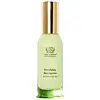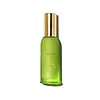What's inside
What's inside
 Key Ingredients
Key Ingredients

 Benefits
Benefits

 Concerns
Concerns

 Ingredients Side-by-side
Ingredients Side-by-side

Calendula Officinalis Flower/Leaf/Stem Juice
Skin ConditioningShea Butter Ethyl Esters
EmollientCarthamus Tinctorius Oleosomes
EmollientWater
Skin ConditioningPropanediol
SolventGlycerin
HumectantDiglycerin
HumectantCetearyl Olivate
Selaginella Lepidophylla Extract
EmollientHelianthus Annuus Seed Oil
EmollientSorbitan Olivate
EmulsifyingSqualane
EmollientButyrospermum Parkii Butter
Skin ConditioningPassiflora Edulis Seed Oil
EmollientSodium Hyaluronate
HumectantCarthamus Tinctorius Seed Oil
MaskingMorus Alba Leaf Extract
Skin ConditioningOphiopogon Japonicus Root Extract
Skin ConditioningChlamydomonas Extract
Skin ConditioningCentella Asiatica Extract
CleansingMagnolia Officinalis Bark Extract
AntimicrobialOenothera Biennis Oil
EmollientOpuntia Ficus-Indica Stem
HumectantPyrus Malus Seed Oil
EmollientRicinus Communis Seed Oil
MaskingVitis Vinifera Seed Oil
EmollientBorago Officinalis Leaf Extract
Skin ConditioningCalendula Officinalis Flower Extract
MaskingChamomilla Recutita Flower Extract
MaskingLavandula Angustifolia Extract
Skin ConditioningMedicago Sativa Extract
TonicGlyceryl Caprylate
EmollientMyrica Cerifera Fruit Wax
EmollientCetyl Palmitate
EmollientSclerotium Gum
Emulsion StabilisingPhenethyl Alcohol
MaskingSodium Levulinate
Skin ConditioningSorbitan Palmitate
EmulsifyingLactic Acid
BufferingSodium Anisate
AntimicrobialMaltodextrin
AbsorbentCalendula Officinalis Flower/Leaf/Stem Juice, Shea Butter Ethyl Esters, Carthamus Tinctorius Oleosomes, Water, Propanediol, Glycerin, Diglycerin, Cetearyl Olivate, Selaginella Lepidophylla Extract, Helianthus Annuus Seed Oil, Sorbitan Olivate, Squalane, Butyrospermum Parkii Butter, Passiflora Edulis Seed Oil, Sodium Hyaluronate, Carthamus Tinctorius Seed Oil, Morus Alba Leaf Extract, Ophiopogon Japonicus Root Extract, Chlamydomonas Extract, Centella Asiatica Extract, Magnolia Officinalis Bark Extract, Oenothera Biennis Oil, Opuntia Ficus-Indica Stem, Pyrus Malus Seed Oil, Ricinus Communis Seed Oil, Vitis Vinifera Seed Oil, Borago Officinalis Leaf Extract, Calendula Officinalis Flower Extract, Chamomilla Recutita Flower Extract, Lavandula Angustifolia Extract, Medicago Sativa Extract, Glyceryl Caprylate, Myrica Cerifera Fruit Wax, Cetyl Palmitate, Sclerotium Gum, Phenethyl Alcohol, Sodium Levulinate, Sorbitan Palmitate, Lactic Acid, Sodium Anisate, Maltodextrin
Hordeum Vulgare Leaf Juice
EmollientMel
EmollientSimmondsia Chinensis Seed Oil
EmollientCitrullus Lanatus Seed Oil
EmollientGlycerin
HumectantGlyceryl Stearate Citrate
EmollientWater
Skin ConditioningPropanediol
SolventC13-14 Alkane
SolventAvena Sativa Kernel Oil
Skin ConditioningNigella Sativa Seed Oil
EmollientPyrus Malus Seed Oil
EmollientSantalum Spicatum Seed Oil
Skin ConditioningSqualane
EmollientBackhousia Citriodora Leaf Extract
AstringentSaccharide Isomerate
HumectantTasmannia Lanceolata Fruit/Leaf Extract
AntioxidantChlorella Vulgaris Extract
Skin ConditioningMagnolia Officinalis Bark Extract
AntimicrobialSalix Alba Bark Extract
AstringentSodium Hyaluronate
HumectantOlea Europaea Fruit Oil
MaskingArnica Montana Extract
Skin ConditioningBorago Officinalis Leaf Extract
Skin ConditioningCalendula Officinalis Flower Extract
MaskingMedicago Sativa Extract
TonicSpiraea Ulmaria Extract
AstringentSambucus Nigra Fruit Extract
AstringentSaccharomyces Ferment
Skin ConditioningPolyglyceryl-3 Stearate
EmulsifyingCaprylyl Glycol
EmollientHydrogenated Lecithin
EmulsifyingLysolecithin
EmulsifyingSclerotium Gum
Emulsion StabilisingGlyceryl Caprylate
EmollientXanthan Gum
EmulsifyingLauroyl Lysine
Skin ConditioningTocopherol
AntioxidantSodium Phytate
Pullulan
Phenethyl Alcohol
MaskingCitrus Limon Fruit Oil
AstringentOcimum Basilicum Oil
MaskingCitrus Aurantium Peel Oil
Citric Acid
BufferingSodium Citrate
BufferingLavandula Angustifolia Oil
MaskingAlcohol
AntimicrobialCymbopogon Flexuosus Oil
MaskingLactic Acid
BufferingFerula Galbaniflua Gum Extract
AntimicrobialLimonene
PerfumingLinalool
PerfumingCitral
PerfumingGeraniol
PerfumingFarnesol
PerfumingCitronellol
PerfumingHordeum Vulgare Leaf Juice, Mel, Simmondsia Chinensis Seed Oil, Citrullus Lanatus Seed Oil, Glycerin, Glyceryl Stearate Citrate, Water, Propanediol, C13-14 Alkane, Avena Sativa Kernel Oil, Nigella Sativa Seed Oil, Pyrus Malus Seed Oil, Santalum Spicatum Seed Oil, Squalane, Backhousia Citriodora Leaf Extract, Saccharide Isomerate, Tasmannia Lanceolata Fruit/Leaf Extract, Chlorella Vulgaris Extract, Magnolia Officinalis Bark Extract, Salix Alba Bark Extract, Sodium Hyaluronate, Olea Europaea Fruit Oil, Arnica Montana Extract, Borago Officinalis Leaf Extract, Calendula Officinalis Flower Extract, Medicago Sativa Extract, Spiraea Ulmaria Extract, Sambucus Nigra Fruit Extract, Saccharomyces Ferment, Polyglyceryl-3 Stearate, Caprylyl Glycol, Hydrogenated Lecithin, Lysolecithin, Sclerotium Gum, Glyceryl Caprylate, Xanthan Gum, Lauroyl Lysine, Tocopherol, Sodium Phytate, Pullulan, Phenethyl Alcohol, Citrus Limon Fruit Oil, Ocimum Basilicum Oil, Citrus Aurantium Peel Oil, Citric Acid, Sodium Citrate, Lavandula Angustifolia Oil, Alcohol, Cymbopogon Flexuosus Oil, Lactic Acid, Ferula Galbaniflua Gum Extract, Limonene, Linalool, Citral, Geraniol, Farnesol, Citronellol
Ingredients Explained
These ingredients are found in both products.
Ingredients higher up in an ingredient list are typically present in a larger amount.
Borago Officinalis Leaf Extract is from the starflower plant. This plant grows primarily in Europe.
Borago Officinalis Leaf Extract is an antioxidant. Antioxidants help fight free-radicals. Free-radicals are molecules that may damage your skin cells.
Calendula Officinalis Flower Extract comes from the common Marigold plant. This ingredient is a skin conditioner.
Marigolds contain flavonoids. Flavonoids are a group of substances found naturally in plants. They possess antioxidant and inflammation properties.
This ingredient soothes skin inflammation by inhibiting inhibiting a part of the inflammation process.
Marigolds have been used in traditional medicine throughout Asia and Europe.
Learn more about Calendula Officinalis Flower ExtractGlycerin is already naturally found in your skin. It helps moisturize and protect your skin.
A study from 2016 found glycerin to be more effective as a humectant than AHAs and hyaluronic acid.
As a humectant, it helps the skin stay hydrated by pulling moisture to your skin. The low molecular weight of glycerin allows it to pull moisture into the deeper layers of your skin.
Hydrated skin improves your skin barrier; Your skin barrier helps protect against irritants and bacteria.
Glycerin has also been found to have antimicrobial and antiviral properties. Due to these properties, glycerin is often used in wound and burn treatments.
In cosmetics, glycerin is usually derived from plants such as soybean or palm. However, it can also be sourced from animals, such as tallow or animal fat.
This ingredient is organic, colorless, odorless, and non-toxic.
Glycerin is the name for this ingredient in American English. British English uses Glycerol/Glycerine.
Learn more about GlycerinGlyceryl Caprylate comes from glycerin and caprylic acid, a fatty acid from coconut. It has emollient and emulsifier properties.
As an emollient, it helps hydrate your skin. Emollients work by creating a barrier on your skin to trap moisture in, helping to keep your skin soft and smooth.
On the other hand, emulsifiers prevent ingredients (such as oil and water) from separating.
Learn more about Glyceryl CaprylateLactic Acid is another well-loved alpha hydroxy acid (AHA). It is gentler than glycolic acid but still highly effective.
Its main role is to exfoliate the surface of the skin by loosening the “glue” that holds dead skin cells together. Shedding those old cells leads to smoother, softer, and more even-toned skin.
Because lactic acid molecules are larger than glycolic acid, they don’t penetrate as deeply. This means they’re less likely to sting or irritate, making it a great choice for beginners or those with sensitive skin.
Like glycolic acid, it can:
Lactic acid also acts as a humectant (like hyaluronic acid). It can draw water into the skin to improve hydration and also plays a role in the skin's natural moisturizing factor (NMF) in the form of sodium lactate.
Studies show it can boost ceramide production to strengthen the skin barrier and even help balance the skin’s microbiome.
To get results, choose products with a pH between 3-4.
Lower strengths (5-12%) focus on surface exfoliation; higher strengths (12% and up) can reach deeper in the dermis (deeper, supportive layer) to improve skin texture and firmness over time.
Though it was originally derived from milk, most modern lactic acid used in skincare is vegan. It is made through non-dairy fermentation to create a bio-identical and stable form suitable for all formulations.
When lactic acid shows up near the end of an ingredient list, it usually means the brand added just a tiny amount to adjust the product’s pH.
Legend has it that Cleopatra used to bathe in sour milk to help reduce wrinkles.
Lactic acid is truly a gentle multitasker: it exfoliates, hydrates, strengthens, and brightens. It's a great ingredient for giving your skin a smooth, glowing, and healthy look without the harshness of stronger acids.
Read more about some other popular AHA's here:
Learn more about Lactic AcidWe don't have a description for Magnolia Officinalis Bark Extract yet.
Medicago Sativa Extract is derived from Alfalfa. It contains antioxidants. Antioxidants help fight free-radicals. Free-radicals are molecules that may damage your skin cells, such as pollution.
Alfalfa is also known as lucerne in the UK, South Africa, and the oceania countries. Ancient Greece and Rome used this plant to feed livestock.
Phenethyl Alcohol is a colorless and aromatic alohol. It is naturally occuring in essential oils.
The scent of this ingredient is floral and often compared to rose.
Like other alcohols, this ingredient helps prevent the growth of bacteria. However, its main purpose is to impact a fragrance.
Learn more about Phenethyl AlcoholPropanediol is an all-star ingredient. It softens, hydrates, and smooths the skin.
It’s often used to:
Propanediol is not likely to cause sensitivity and considered safe to use. It is derived from corn or petroleum with a clear color and no scent.
Learn more about PropanediolPyrus Malus Seed Oil is an oil.
Sclerotium Gum is a polysaccharide gum made by the fungus, Sclerotium rolfssii. It is similar to xanthan gum.
In cosmetics, Sclerotium Gum is used to thicken the texture and to help stabilize other ingredients.
As an emulsifier, Sclerotium Gum helps prevent ingredients from separating, such as water and oil.
Learn more about Sclerotium GumSodium Hyaluronate is hyaluronic acid's salt form. It is commonly derived from the sodium salt of hyaluronic acid.
Like hyaluronic acid, it is great at holding water and acts as a humectant. This makes it a great skin hydrating ingredient.
Sodium Hyaluronate is naturally occurring in our bodies and is mostly found in eye fluid and joints.
These are some other common types of Hyaluronic Acid:
Learn more about Sodium HyaluronateSqualane is an emollient that helps the skin hold onto moisture. It's an oily liquid that occurs naturally in certain types of fish and plant oils.
Because squalane boosts hydration in the skin, it also comes with plenty of benefits: it is an antioxidant and can help fight free radicals and skin damage. Squalane is also found to have a detoxifying effect when applied.
Squalane comes from squalene, which occurs naturally within the sebum of our skin. It is one of the oils our skin produces to keep itself hydrated. Squalane is the hydrogenated version of squalene and has a longer shelf life.
Research shows that squalane is non-irritating (even at 100% concentration).
In general, it's a fantastic ingredient. It does a great job at hydrating the skin, and it's suitable for those with sensitive skin.
The source of squalane may impact malassezia / fungal acne. This is because olive oil derived squalane can contain impurities such as fatty acids and plant waxes. Sugarcane derived squalane is recommended for anyone with malassezia concerns.
Is squalane vegan?
This depends on the source. Squalane can be derived from both plants and animals. Most squalane used in skincare comes from plants.
Please note: the source of squalane is only known if disclosed by the brand. We recommend reaching out to the brand if you have any questions about their squalane.
Read more about squalene with an "e".
Is squalane an oil?
Squalane is often called an oil, but it’s technically not; it’s a hydrocarbon, meaning it’s only made of carbon and hydrogen, unlike true oils which are triglycerides made of fatty acids and glycerol.
The term “oil-free” isn’t regulated, so companies can define it however they want. Some exclude all oils, while others just avoid mineral oil or comedogenic oils.
While some people avoid oils thinking they cause breakouts, the right kind of oil (or oil-like ingredient like squalane) can actually help balance and hydrate your skin. It’s worth testing out simple oils or squalane to see what works best for your skin.
Learn more about SqualaneWater. It's the most common cosmetic ingredient of all. You'll usually see it at the top of ingredient lists, meaning that it makes up the largest part of the product.
So why is it so popular? Water most often acts as a solvent - this means that it helps dissolve other ingredients into the formulation.
You'll also recognize water as that liquid we all need to stay alive. If you see this, drink a glass of water. Stay hydrated!
Learn more about Water